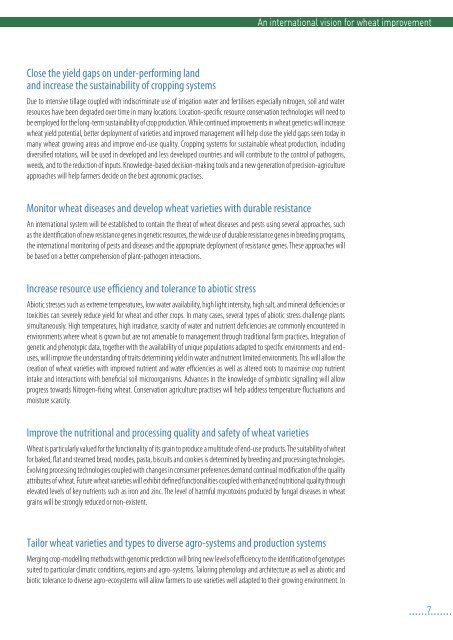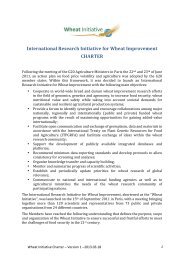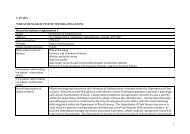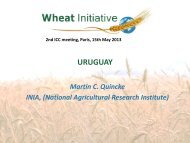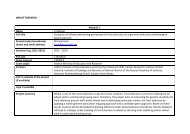An international vision for wheat improvement - Wheat Initiative
An international vision for wheat improvement - Wheat Initiative
An international vision for wheat improvement - Wheat Initiative
You also want an ePaper? Increase the reach of your titles
YUMPU automatically turns print PDFs into web optimized ePapers that Google loves.
<strong>An</strong> <strong>international</strong> <strong>vision</strong> <strong>for</strong> <strong>wheat</strong> <strong>improvement</strong><br />
Close the yield gaps on under-per<strong>for</strong>ming land<br />
and increase the sustainability of cropping systems<br />
Due to intensive tillage coupled with indiscriminate use of irrigation water and fertilisers especially nitrogen, soil and water<br />
resources have been degraded over time in many locations. Location-specific resource conservation technologies will need to<br />
be employed <strong>for</strong> the long-term sustainability of crop production. While continued <strong>improvement</strong>s in <strong>wheat</strong> genetics will increase<br />
<strong>wheat</strong> yield potential, better deployment of varieties and improved management will help close the yield gaps seen today in<br />
many <strong>wheat</strong> growing areas and improve end-use quality. Cropping systems <strong>for</strong> sustainable <strong>wheat</strong> production, including<br />
diversified rotations, will be used in developed and less developed countries and will contribute to the control of pathogens,<br />
weeds, and to the reduction of inputs. Knowledge-based decision-making tools and a new generation of precision-agriculture<br />
approaches will help farmers decide on the best agronomic practises.<br />
Monitor <strong>wheat</strong> diseases and develop <strong>wheat</strong> varieties with durable resistance<br />
<strong>An</strong> <strong>international</strong> system will be established to contain the threat of <strong>wheat</strong> diseases and pests using several approaches, such<br />
as the identification of new resistance genes in genetic resources, the wide use of durable resistance genes in breeding programs,<br />
the <strong>international</strong> monitoring of pests and diseases and the appropriate deployment of resistance genes. These approaches will<br />
be based on a better comprehension of plant-pathogen interactions.<br />
Increase resource use efficiency and tolerance to abiotic stress<br />
Abiotic stresses such as extreme temperatures, low water availability, high light intensity, high salt, and mineral deficiencies or<br />
toxicities can severely reduce yield <strong>for</strong> <strong>wheat</strong> and other crops. In many cases, several types of abiotic stress challenge plants<br />
simultaneously. High temperatures, high irradiance, scarcity of water and nutrient deficiencies are commonly encountered in<br />
environments where <strong>wheat</strong> is grown but are not amenable to management through traditional farm practices. Integration of<br />
genetic and phenotypic data, together with the availability of unique populations adapted to specific environments and enduses,<br />
will improve the understanding of traits determining yield in water and nutrient limited environments. This will allow the<br />
creation of <strong>wheat</strong> varieties with improved nutrient and water efficiencies as well as altered roots to maximise crop nutrient<br />
intake and interactions with beneficial soil microorganisms. Advances in the knowledge of symbiotic signalling will allow<br />
progress towards Nitrogen-fixing <strong>wheat</strong>. Conservation agriculture practises will help address temperature fluctuations and<br />
moisture scarcity.<br />
Improve the nutritional and processing quality and safety of <strong>wheat</strong> varieties<br />
<strong>Wheat</strong> is particularly valued <strong>for</strong> the functionality of its grain to produce a multitude of end-use products. The suitability of <strong>wheat</strong><br />
<strong>for</strong> baked, flat and steamed bread, noodles, pasta, biscuits and cookies is determined by breeding and processing technologies.<br />
Evolving processing technologies coupled with changes in consumer preferences demand continual modification of the quality<br />
attributes of <strong>wheat</strong>. Future <strong>wheat</strong> varieties will exhibit defined functionalities coupled with enhanced nutritional quality through<br />
elevated levels of key nutrients such as iron and zinc. The level of harmful mycotoxins produced by fungal diseases in <strong>wheat</strong><br />
grains will be strongly reduced or non-existent.<br />
Tailor <strong>wheat</strong> varieties and types to diverse agro-systems and production systems<br />
Merging crop-modelling methods with genomic prediction will bring new levels of efficiency to the identification of genotypes<br />
suited to particular climatic conditions, regions and agro-systems. Tailoring phenology and architecture as well as abiotic and<br />
biotic tolerance to diverse agro-ecosystems will allow farmers to use varieties well adapted to their growing environment. In<br />
7


